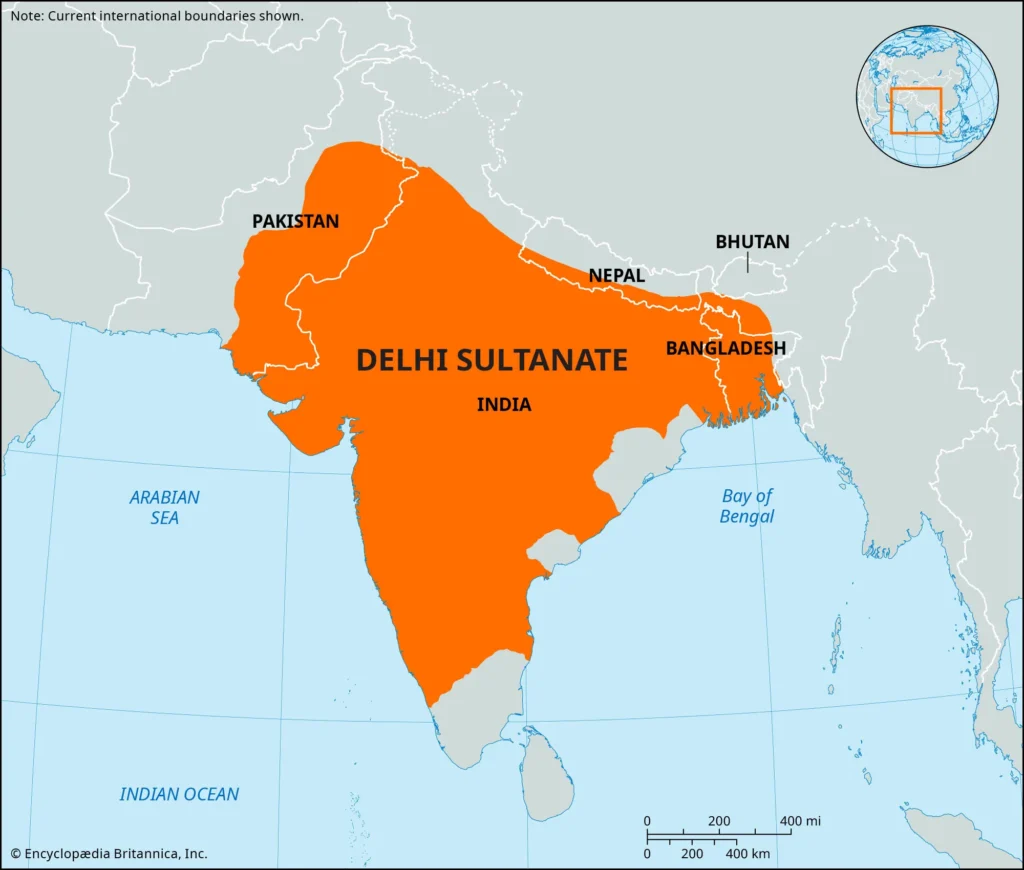Delhi Sultanate administration system of India
The establishment of Turkish rule in India during the last decade of 12th century AD, marked the beginning of new phase in Indian history because for many centuries hereafter India was ruled by Turko-Afghan rulers. This came to known as Delhi Sultanate. Turkish rule was started in India after the defeat of Prithviraj Chauhan in the second battle of Tarrain, c. 1192 AD.
Before that, their rule was limited to north-western parts of India. After establishment of their rule in India, number of changes were brought by them in politico-administration system. Some of changes were quite successful, so they continued for centuries.
Also Read : Turkish Rule in India: Changes in Technology and Economy
Turkish Rule in India: Impact on Military and Socio-Cultural Life
Establishment of Turkish Rule in India
Politico-Administration of Delhi Sultanate
The politico-administration system of India during Sultanate period was characterized by number of changes and continuity while some of state system continued from beginning came to an end without much variation. While a number of other features evolved with passage of time. The information about administration system was provided by sources such as Tabatqat-i-Nasiri of Minhaj-ud-din Siraj and Tariz-i-Firoz Shahi of Ziauddin Barani.
Elements of Change
During the reign of Mohammad Ghori, the Turkish Indian empire was not an independent entity but was a part of Central Asian Ghurid Empire. Qutub-ud-din-Aibak and Iltutmish transformed the empire in an independent and sovereign entity. They cut off the all the external relations in elegance of and subservience. Balban and Alauddin Khilji transformed the Sultanate into strong centralized despotic state.

During the reign of Alauddin Khilji and Mohammad Bin Tughlaq, Sultanate assumed the character of pan-Indian empire as they carried the Turkish flag beyond Vindhayas. Aladdin conquered south-India. During the reign of Firoz Shah Tughlaq, sultanate assumed the character of decentralized state as the Iqta system was made hereditary by him.
During the reign of Lodhis, sultanate assumed the character of confederacy, because Lodhis followed the Afghan theory of Kingship. In this theory, Sultan was considered first among equals. The Iqtadars (head of Iqta) were allowed to retain entire revenue coming from their Iqtas.
Elements of Continuity
The politico-administration system of Delhi Sultanate was monarchial in character because the position of sultan was very much similar to the kings of Ancient India. But the monarchial system was not well developed because there no fixed law of succession. Almost every time the issue of succession was decided in battle field. Sultanate was an example of despotic state because the office of Sultan was powerful.
In theory, the sultan was supposed to follow Shariat (Islamic law) and consult Ulemas (Islamic religious heads) but in practical the order of sultan was final. The influence of Ulemas was only seen during the reign of weak sultans like Firoz Shah Tughlaq. The powerful Sultans like Alauddin and Mohammad Bin Tughlaq didn’t allow Ulemas to interfere in political matters.
The political system of Delhi sultanate was centralized in nature because Sultan maintained effective control over the administration of state with the help of provincial and sub-provincial officials as order issued directly by Sultan. Sultanate was an Islamic state at least in formal sense because Islam was the religion of state as well as of ruling class. But it was during the reign of Mohammad Bin Tughlaq, sultanate assumed the character of secular state.
He did not peoples on the basis of religion and beliefs. He even used to celebrate Holi in his court. There was Portfolio system during Delhi Sultanate. Diwan-i-wazir was the department of Prime minister and Finance minister. Diwan-i-arz was military department. Diwan-i-insha was the department of royal correspondence. Diwan-i-risalat was the department of foreign affairs.
They also Iqta system which was headed by Iqtadars, who looked after revenue and military at provincial level. Delhi sultanate was an example of military state. A military state refers to such a political entity who establishment and existence was dependent on the power of military. Till the time, military was strong, sultanate continued to prosper. When military power lost its character, Sultanate was started to decline.
In military state, the civil and military functions were performed by same groups of officials. No differentiation was there between civil and military officers. Delhi sultanate was also a police state, the revenue collecting authority also maintained law and order. Police state did not take measures for the welfare of common peoples. Sultans of Delhi did not focus on welfare of peoples but only focus on strengthening their authority.
It was during the Mohammad and Firoz Tughlaq, the Sultanate assumed the welfare character. Mohammad helped in development of irrigation facilities. Firoz Shah built hospital for Muslim subjects. Free kitchens were established by sultan. Grants and person were issued to needy and poor peoples. Elements of cultural state were also visible in sultanate because Sultans took deep interest in cultural activities.
Scholars were patronized by Sultan in their court. For example, Amir Khusrau in the court of Alauddin Khilji. Schools were established for promotion of learning, number of monuments were constructed in the form of Tombs, mosques, palaces etc. Hence, Delhi sultans were not only an efficient administrator and successful military conquerors but they took deep interest in cultural activities.
Sultanate was as strong imperialistic state because Sultans of Delhi followed the policy of territorial extension. Military campaigns were organized continuously by rulers of Delhi to extend territories controlled by them.
The politico-administration included both the elements of change and continuity. While some of the elements were similar to ancient Indian elements while some new elements were introduced by Turkish rulers.
